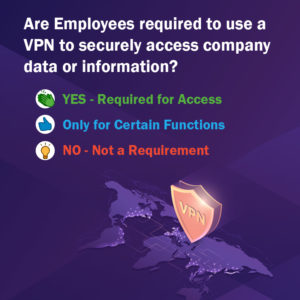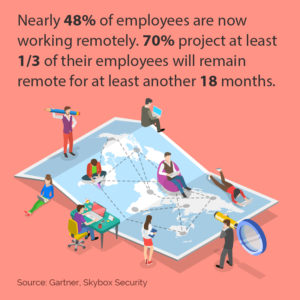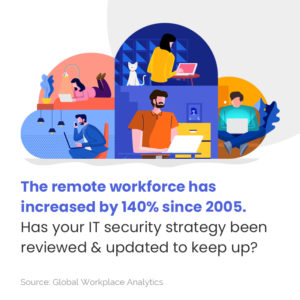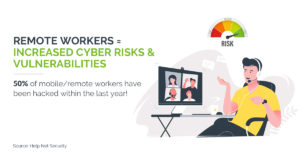


The COVID-19 pandemic has changed everything about the world as we know it. Just as we started embracing new practices like sanitizing, social distancing and remote working, the pandemic has also forced us to embrace systemic changes in the ways we deal with cyberthreats. In fact, the FBI has reported an increase in cyberattacks to 4,000 per day in 2020, which is 400 percent higher than the attacks reported before the onset of the coronavirus.
Since remote working is here to stay, the trend in increasing cyberattacks is expected to continue well into the future. Moreover, business technologies are also transforming, attracting more cybercriminals to target business data. In these circumstances, the best solution is to build your cyber resiliency and protect yourself from unforeseen attacks.
Remote Working and Cybersecurity
Cybersecurity has always been a challenge for businesses with sensitive data. A single unexpected breach could wipe out everything and put your existence in question. With the sudden transition to remote working, this challenge has increased manifold for security teams. From the potential safety of the remote working networks to trivial human errors, there are endless ways in which your IT network could be affected when employees are working remotely.
A study by IBM Security has estimated that about 76 percent of companies think responding to a potential data breach during remote working is a much more difficult ordeal. Also, detecting breaches early is another big issue for IT security teams. The same study by IBM has estimated that it takes companies roughly about 197 days to detect a breach and 69 days to contain it. Is your cybersecurity posture good enough to withstand a potential attack?
Threats You Need to Be Aware of
Cyberthreats come in different shapes and forms. From a simple spyware monitoring your network transactions to a full-fledged ransomware attack that holds all your critical data for a ransom, there are multiple ways in which your IT network could be affected. Only when you get the idea of the potential risks surrounding your IT infrastructure, you can build a resilient cybersecurity strategy that enhances your IT environment and keeps vulnerabilities at bay.
Let’s look at some of the common cyberthreats that businesses faced in 2020:
- Phishing scams: Phishing emails still pose a major threat to the digital landscape of many business organizations across the globe. COVID-19 communications have provided the perfect cover for these emails to lure unsuspecting users. By creating a sense of urgency, these emails might persuade your employees to click on malware links that could steal sensitive data or install malicious viruses inside a computer.
- Ransomware: Targeted ransomware attacks are increasing every day. It is estimated that a ransomware attack will happen every 11 seconds in 2021. Ransomware attacks hold an organization’s critical data for a ransom, and millions of dollars are paid to hackers every year as corporates do not want to risk losing their sensitive data. However, there is no guarantee that your files will be secure even after you pay the ransom.
- Cloud Jacking: With the cloud becoming a more sophisticated way of storing data, incidents of cloud jacking has become a serious threat. These attacks are mainly executed in two forms – injecting malicious code into third-party cloud libraries or injecting codes directly to the cloud platforms. As estimated by the 2020 Forcepoint Cybersecurity Predictions, a public cloud vendor is responsible for providing the infrastructure while most of the responsibility concerning data security rests with the users. So, bear in mind, you are mostly responsible for your data security even when it is on the cloud.
- Man-in-the-middle attack: Hackers can insert themselves in a two-party transaction when it happens on a public network. Once they get access, they can filter and steal your data. If your remote working employees use public networks to carry out their official tasks, they are vulnerable to these attacks.
- Distributed Denial-of-Service attack: This attack happens when hackers manipulate your normal web traffic and flood the system with resources and traffic that exhaust the bandwidth. As a result, users will not be able to perform their legitimate tasks. Once the network is clogged, the attacker will be able to send various botnets to the network and manipulate it.
Protecting Your Business from Cyberthreats
Security readiness is something all organizations must focus on irrespective of their size. It is mandatory to have an action plan that outlines what needs to be done when something goes wrong. Most importantly, it is critical to have a trusted MSP partner who can continuously monitor your IT infrastructure and give you a heads-up on usual activities.
Investing in cybersecurity solutions is way cheaper than losing your critical data or paying a large ransom. You need to deploy advanced solutions that can keep up with the sophisticated threats of this modern age. Then, there is a list of best practices such as multi-factor authentication, DNS filtering, disk encryption, firewall protection and more.
If all these aspects of cybersecurity sound daunting to you, fret not. Reach out to us today to get a full understanding of the vulnerabilities in your network and how you can safeguard your data with the right tools and techniques.






Data Sources:
- https://www.prnewswire.com/news-releases/top-cyber-security-experts-report-4-000-cyber-attacks-a-day-since-covid-19-pandemic-301110157.html#:~:text=Cybercrime%20Statistics%20During%20the%20Pandemic,they%20were%20seeing%20pre%2Dcoronavirus
- IBM 2020 Cost of a Data Breach Report
- https://www.idagent.com/blog/10-2020-ransomware-statistics-that-you-need-to-see/
- 2020 Forcepoint Cybersecurity Predictions and Trends
Article curated and used by permission.
